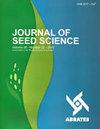Chemical treatment and storage of sorghum seeds produced in different management zones
IF 1.2
4区 农林科学
Q3 AGRONOMY
引用次数: 0
Abstract
Abstract: Precision Agriculture considers soil attributes and production aspects to define management zones. Although there is little information, it is likely that seeds produced in different management zones have different quality after chemical treatment and storage. The aim was to evaluate the physiological quality of sorghum seeds produced in different management zones, after chemical treatment and storage. The management zones were defined from interpolated maps of soil and vegetation attributes with the aid of the Smart Map - SMP plugin, in a Qgis environment. After harvest, the seeds were treated with Thiamethoxam, Imidacloprid + Thiodicarb, Fludioxonil + Metalaxyl-M and a control treatment (water). Then, they were stored for 0, 60 and 120 days. The seeds were evaluated for their quality through the following tests: moisture, germination, dry mass of seedlings, electrical conductivity, and accelerated aging. The design was completely randomized in a 4 × 3 factorial scheme, with the management zones being analyzed independently. Sorghum seed treatments with insecticides cause greater phytotoxicity during storage in both management zones, unlike the fungicide treatment. Sorghum seeds produced in high-management zones have high physiological quality and less deterioration during storage. Sorghum seeds produced in low-management zones treated with insecticides, as the storage time increases, show lower vigor due to deterioration and phytotoxicity.不同经营区域高粱种子的化学处理与贮藏
摘要:精准农业考虑土壤属性和生产方面来界定管理区域。虽然资料很少,但很可能不同管理区域生产的种子经过化学处理和储存后品质不同。目的是评价不同经营区域生产的高粱种子经化学处理和贮藏后的生理品质。在Qgis环境下,借助Smart Map - SMP插件,从插值的土壤和植被属性图中定义管理区域。收获后,分别用噻虫嗪、吡虫啉+噻虫威、氟虫腈+甲氨苄和对照(水)处理。然后分别保存0、60和120天。通过以下测试来评价种子的质量:水分、发芽、幼苗干质量、电导率和加速老化。设计采用4 × 3因子方案完全随机化,管理区域独立分析。与杀菌剂处理不同,用杀虫剂处理高粱种子在两个管理区的储存期间会造成更大的植物毒性。高管理区生产的高粱种子生理品质高,贮藏变质少。低管理地区的高粱种子经杀虫剂处理后,随着贮藏时间的延长,其活力因变质和植物毒性而降低。
本文章由计算机程序翻译,如有差异,请以英文原文为准。
求助全文
约1分钟内获得全文
求助全文
来源期刊

Journal of Seed Science
Agricultural and Biological Sciences-Agronomy and Crop Science
CiteScore
2.00
自引率
30.00%
发文量
28
审稿时长
12 weeks
期刊介绍:
From 2017 the Journal of Seed Science (JSS) will circulate online version only.
Original scientific studies and communications, not yet published or submitted to another journal for publication and written in Portuguese or English, will be accepted for publication. For manuscripts submitted in English, the authors should provide an adequated version.
The SCIENTIFIC COMMUNICATION is a category of scientific manuscript which describes a technique, an equipment, new species or observations and surveys of limited results. It has the same scientific rigor as the “Scientific Articles” and the same value as a publication. The classification of a manuscript as a SCIENTIFIC COMMUNICATION is based on its content and scientific merit but it can be a preliminary study, simple and not definitive on a certain subject, with publication justified by its uniqueness and contribution to the area.
The Editorial Board of the JSS may invite leading authors of recognized reputation to compose specific Review Articles covering topics of their specialization that will convey to the scientific community the state-of-the-art knowledge related to the specific theme.
 求助内容:
求助内容: 应助结果提醒方式:
应助结果提醒方式:


